
Not long ago, I made the comment that I never thought I’d see the day an industrial hemp feature would be on the cover of Dakota Farmer — our sister publication, which featured an industrial hemp farmer on its cover earlier this year in January.
Of course, if you’ve read our August print issue or have been paying attention to the news at all this summer, you’re probably aware that the Nebraska Legislature legalized the commercial production of industrial hemp.
In the months leading to the unicameral wrapping up in June, and in the months following, I’ve heard questions from more farmers than I ever thought would have been interested in growing industrial hemp in Nebraska. At a recent Midwest Hemp Forum in Nebraska, I witnessed lots of enthusiasm from farmers in attendance. When you think about it, it really isn’t all that surprising — margins are tight with low commodity prices, and farmers are looking for just about any change that will bring them revenue.
Sure, there are some pretty big pie-in-the-sky numbers being thrown out there in terms of industrial hemp profit potential, but one thing’s for certain — there is demand for certain hemp-based products.
Some of the higher-profit potential lies in growing industrial hemp for CBD oil production. Although many believe Nebraska growers eventually will fill a niche in hemp fiber production, growers in places such as North Dakota have still been able to turn a healthy profit by growing hemp for fiber. And some growers in Nebraska may opt for the more labor-intensive CBD production.
Of course, many have pointed out that industrial hemp won’t entirely supplant corn and soybean acres — it’s an entirely different production system, after all. However, the hope is many will find an opportunity for profit by filling a niche in the market, which Nebraska, with its water resources and productive soils, is well-suited to.
It’s not all that different from other niche markets growers have tapped into. Take hops, for example. Nebraska isn’t going to take the place of the Pacific Northwest — where the bulk of the nation’s hops are grown — anytime soon.
However, hops production has proved to be a viable option for some farmers and ranchers seeking to diversify their operations and meet the rising demands of Nebraska’s craft brewing industry.
I recently wrote about a farmer in the Nebraska Panhandle who’s growing peppermint — a crop found in different states in the Intermountain West and Upper Midwest and scarcely, if ever, found in Nebraska.
That farmer also is growing chicory (another new crop to the Panhandle) to grind into flour for baked goods such as granola bars, bread, chips and cookies.
Other farmers, already dealing with herbicide-resistant weeds, are in the middle of transitioning to organic corn and soybean production, and upping the ante in their cover crop usage to keep the ground covered and help keep weeds in check.
That’s not to say changing up your entire crop rotation or production system is going to work for everyone. Sometimes change is warranted. Sometimes it can cause more strain than is already there. The point is, it pays to have an open mind.
It isn’t always easy or economically feasible to change a production system or add a new component to it. For those willing to run the numbers and try something they hadn’t previously considered, it may give them the profit boost they’re looking for.
About the Author(s)
You May Also Like






